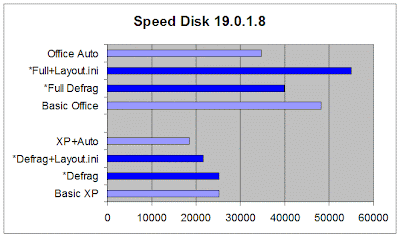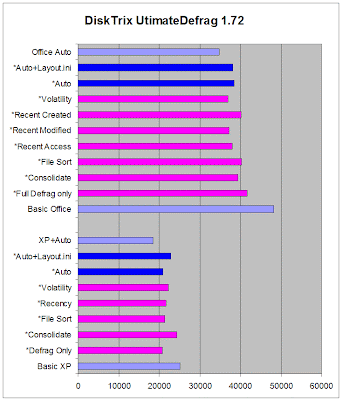
Thursday, December 20, 2007
Electricity Situation Gets Worse

Tuesday, December 18, 2007
Charismatic Dimwit

Friday, December 14, 2007
Benchmarks*: Puran Defrag 4.0
 Puran Defrag 4.0 was released recently. You can find a review of version 3, and the test results are shown below. It's results are impressive, and much better than I expected, and better than version 3.
Puran Defrag 4.0 was released recently. You can find a review of version 3, and the test results are shown below. It's results are impressive, and much better than I expected, and better than version 3. The graph shows Puran Defrag 4 (PD4) in dark blue, and the results from Windows XP in light blue. The first test is at the bottom, and shorter lines mean faster times.
The graph shows Puran Defrag 4 (PD4) in dark blue, and the results from Windows XP in light blue. The first test is at the bottom, and shorter lines mean faster times.- "Basic XP" refers to the standard install, without Office 2007, so there are only 710 files to be tested.
- "Defrag" refers to the read times of the same 710 files, after two defrag passes using the full PD4 boot time defrag, with no "Optimize Files" or "Optimize Boot" options enabled. A 17.3% performance improvement is measured.
- "Defrag+Auto" refers to the read time after enabling both the "Optimize Boot" function in Windows, and then allowing Windows to optimise the placement of system files. After this a further boot time defrag is done, with no additional options. An improvement of 32.6% is recorded, 8.1% faster than WDD.
- "XP+Auto" is the result obtained after enabling both "Optimize Files" and "Optimize Boot" functions in Windows, and then running WDD, i.e. the best that Windows XP can manage.
- "Basic Office" refers to the read time of all 802 test files, where no defragmentation has been done whatsoever, after the installation of Microsoft Office 2007 Professional (Trial).
- "Full Defrag" refers to the read times of the same 802 files, after a full boot time defrag with all options enabled, with no "Optimize Files" or "Optimize Boot" options enabled. A 27.6% performance improvement is measured, as good as the Office Auto result below..
- "Full Defrag+Auto" refers to the read time after enabling both the "Optimize Boot" function in Windows, and then allowing Windows to move the system files around. After that a simple boot time defrag, with no additional options, was run. An improvement of 32.3% is recorded, 6.2% faster than WDD.
- "Office Auto" is the result obtained by allowing Windows XP to do its own defrag after enabling both "Optimize Files" and "Optimize Boot" functions.
Thursday, December 13, 2007
Puran Defrag 4.0 special offer
Update 1 Jan 2008: the special offer price is now $19.95
Benchmarks*: Norton Utilities Speed Disk 19.0.1.8

 The graph shows Norton Speed Disk (NSD) in dark blue, and the results from Windows XP in light blue. The first test is at the bottom, and shorter lines mean faster times.
The graph shows Norton Speed Disk (NSD) in dark blue, and the results from Windows XP in light blue. The first test is at the bottom, and shorter lines mean faster times.- "Basic XP" refers to the standard install, without Office 2007, so there are only 710 files to be tested.
- "Defrag" refers to the read times of the same 710 files, after two defrag passes using NSD, with no "Optimize Files" or "Optimize Boot" options enabled. No performance improvement is measured at all.
- "Auto+Layout.ini" refers to the read time after enabling the "Optimize Boot" function in Windows, and then running NSD after Windows had done is standard boot optimise. An improvement of 14.1% is recorded, still slower than WDD.
- "XP+Auto" is the result obtained after enabling both "Optimize Files" and "Optimize Boot" functions in Windows, and then running WDD, i.e. the best that Windows XP can manage.
- "Basic Office" refers to the read time of all 802 test files, where no defragmentation has been done whatsoever, after the installation of Microsoft Office 2007 Professional (Trial).
- "Full Defrag" refers to the read times of the same 802 files, after two defrag passes using NSD, with no "Optimize Files" or "Optimize Boot" options enabled. A 17.2% performance improvement is measured, the best result obtained.
- "Full+Layout.ini" refers to the read time after enabling the "Optimize Boot" function in Windows, and then running NSD several times. An improvement of -14.2% is recorded, much slower than WDD.
- "Office Auto" is the result obtained by allowing Windows XP to do its own defrag after enabling both "Optimize Files" and "Optimize Boot" functions.
Sunday, December 02, 2007
Benchmarks*: Disktrix UltimateDefrag 1.72
 I have reviewed a previous version of UltimateDefrag 1.72, and posted the results of testing here. This has been the most complex of all the products to benchmark, because of the bewildering array of file placement options. The results show a representative cross-section of these options, using default values wherever possible. I have no explanation why the basic WDD results are faster, but these are still raw results.
I have reviewed a previous version of UltimateDefrag 1.72, and posted the results of testing here. This has been the most complex of all the products to benchmark, because of the bewildering array of file placement options. The results show a representative cross-section of these options, using default values wherever possible. I have no explanation why the basic WDD results are faster, but these are still raw results. The graph shows UltimateDefrag 1.72 (UD) in dark blue, and the results from Windows XP in light blue. The first test is at the bottom, and shorter lines mean faster times. The magenta lines are the results obtained using each of the main file placement options.
The graph shows UltimateDefrag 1.72 (UD) in dark blue, and the results from Windows XP in light blue. The first test is at the bottom, and shorter lines mean faster times. The magenta lines are the results obtained using each of the main file placement options.- "Basic XP" refers to the standard install, without Office 2007, so there are only 710 files to be tested.
- "Defrag Only" refers to the read times of the same 710 files, after two defrag passes using the UD "defragment only" option, with no "Optimize Files" or "Optimize Boot" options enabled. A 17.3% performance improvement is measured.
- "Consolidate" refers to the UD "Consolidate" option, which returned a 3.1% performance improvement.
- "File Sort" refers to the UD "File/Folder" option, which returned a 15.1% performance improvement.
- "Recency" refers to the UD "Recency" (Date Modified) option, which returned a 13.9% performance improvement.
- "Volatility" refers to the UD "Volatility" option, which returned a 11.5% performance improvement.
- "Auto" refers to the UD "Auto" option, which returned a 16.7% performance improvement.
- "Auto+Layout.ini" refers to the read time after enabling both the "Optimize Boot" function in Windows, and then running UD Auto with "respect Layout.ini" enabled. An improvement of 9.1% is recorded, still slower than WDD.
- "XP+Auto" is the result obtained after enabling both "Optimize Files" and "Optimize Boot" functions in Windows, and then running WDD, i.e. the best that Windows XP can manage.
- "Basic Office" refers to the read time of all 802 test files, where no defragmentation has been done whatsoever, after the installation of Microsoft Office 2007 Professional (Trial).
- "Full Defrag Only" refers to the read times of the same 802 files, after two defrag passes using the UD "defragment only" option, with no "Optimize Files" or "Optimize Boot" options enabled. A 13.6% performance improvement is measured.
- "Consolidate" refers to the UD "Consolidate" option, which returned a 18.3% performance improvement.
- "File Sort" refers to the UD "File/Folder" option, which returned a 16.5% performance improvement.
- "Recent Access" refers to the UD "Recency" (Date Last Accessed) option, which returned a 21.1% performance improvement.
- "Recent Modified" refers to the UD "Recency" (Date Modified) option, which returned a 22.7% performance improvement.
- "Recent Created" refers to the UD "Recency" (Date Created) option, which returned a 16.6% performance improvement.
- "Volatility" refers to the UD "Volatility" option, which returned a 23.2% performance improvement.
- "Auto" refers to the UD "Auto" option, which returned a 20.1% performance improvement.
- "Auto+Layout.ini" refers to the read time after enabling both the "Optimize Boot" function in Windows, and then running UD Auto with "respect Layout.ini" enabled. An improvement of 21.0% is recorded, still slower than WDD.
- "Office Auto" is the result obtained by allowing Windows XP to do its own defrag after enabling both "Optimize Files" and "Optimize Boot" functions.
 The image here is for the second "Volatility" option. Notice how the file placement is completely different to the "Auto" option at the top of the article.
The image here is for the second "Volatility" option. Notice how the file placement is completely different to the "Auto" option at the top of the article.
Subscribe to:
Comments (Atom)